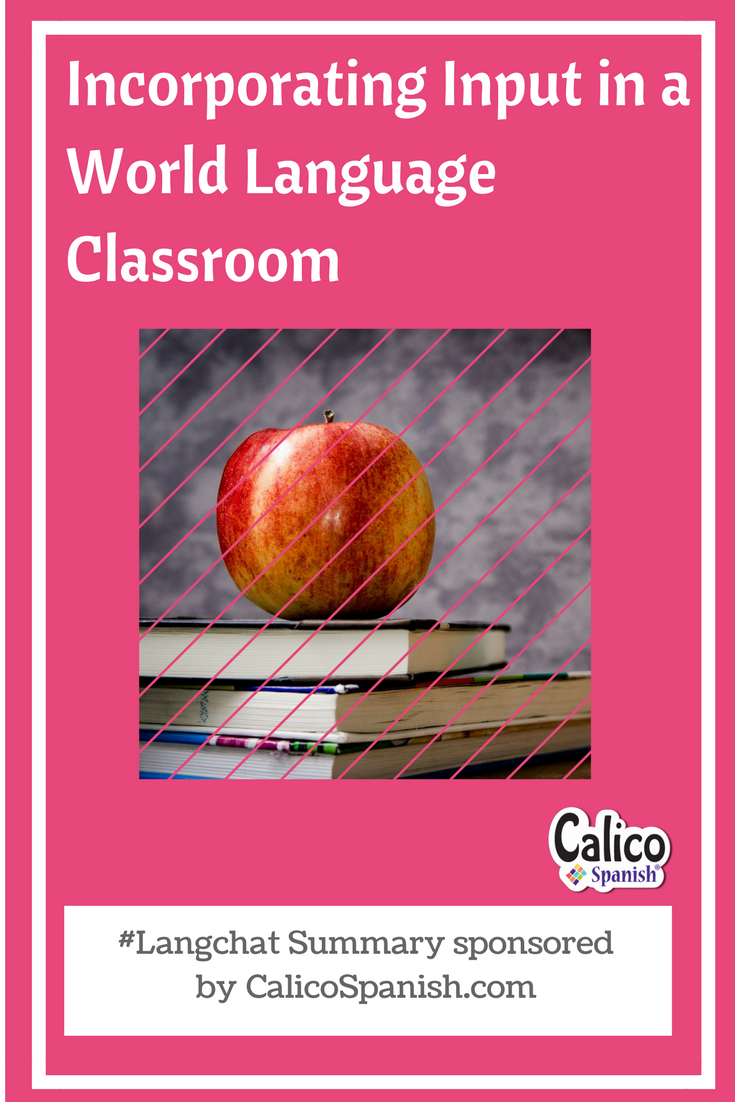Incorporating Input in a World Language Classroom
 Incorporating successful input is an essential teaching function in a World Language Classroom. Last week, #langchat participants discussed factors for evaluating potential input, strategies to demonstrate student comprehension, grading and sequencing input activity techniques.
Incorporating successful input is an essential teaching function in a World Language Classroom. Last week, #langchat participants discussed factors for evaluating potential input, strategies to demonstrate student comprehension, grading and sequencing input activity techniques.
– Follow the blog on Bloglovin –
Factors to Evaluate Potential Input
There are several factors that #Langchat teachers have used to evaluate a new or already existing potential input source. @srtafenton said, “I want input that can be an authentic model for what students will eventually create on output.” Factors such as “[high frequency] vocab, interesting, relevant, and level appropriate” material are looked for when selecting appropriate input (@VTracy7). @LauraErinParker said, “I find authentic texts and then look at text features, vocabulary complexity, and evaluate structures such as tense, connectors, etc.” Many #langchat participants shared that comprehensibility was a major factor that they searched for when evaluating input. “I prefer authentic, comprehensible, high-interest, [and] culturally rich [input]” (@mmeshep). @MmeBlouwolff said, “ideally [input] keeps us on track with the unit theme.”
– Like Calico Spanish on Facebook –
Strategies to Demonstrate Student Comprehension
Listening and Viewing Input
#Langchat teachers have shared several successful strategies for assessing student comprehension during listening and viewing input.
- @Marishawkins shared, “for listening I love @EDpuzzle! For my online readings, I also love embedding questions and polls using @activelylearn!”
- @MmeBlouwolff said, “I am trying to do more hold-ups (Yes/No cards, etc.) and sorting cards so that there is a hands-on aspect to go with my text or video.”
- @marthaca82 said, “quick formative assessments tickets out are my favorite or pause and check for understanding.”
- @dressurleben contributed:
For teaching new vocab, I give students a paper with English on one side [and] target language on the other. They have to connect the word with [the] definition.
- @welangley said, “a quick ‘What does ‘Spanish word’ mean?’ is super effective.”
– Follow Calico Spanish on Twitter –
Written Input
In addition, #Langchat teachers also shared different strategies for assessing student comprehension during written input.
- @MlleSulewski said, “I enjoy having [students] use different colors to highlight different elements within a text.”
- @welangley suggests using “volleyball reading, choral translation, [and] drawing pictures.”
- “I have my [students] create their own comprehension questions after reading. Then they trade. Others’ questions spur more thought,” said @ShannonRRuiz.
- @LauraErinParker said, “There are so many different ways – depends on the resource. [My] favorite is venn diagram for cultural comparisons.”
Grading Without Relying Solely on Comprehension Questions
#Langchat participants find it challenging to grade interpretive mode without over-reliance on low-level comprehension questions. It is important to remember that:
assessing [interpretations] should be done in [the native language] to avoid errors caused by lack of [second language] knowledge @ShannonRRuiz
Introduce a child you love to a lifelong journey of speaking real Spanish to real people. Click the red button to experience it FREE.
@Marishawkins grades “using personalized questions in Spanish.” Although “it isn’t interpretive” she “likes asking them to apply what they read.” @salaamay uses “character maps” to assess. “Doing a speech as one of the characters [or] writing a letter to one of the characters” are also fun assessment techniques (@salaamay). “Depending on type, you could have students use what they learned. Ex: Solution to pollution from text on water pollution” (@LauraErinParker).
– Follow us on Instagram too! –
Sequencing Multiple Input Activities to Prepare Students
Having a variety and a high amount of input in lessons proved to be a common recommendation for sequencing multiple input activities to best prepare students for language use. @Marishawkins said, “I have found that I have to prepare students for the input activities by pre-teaching. [Students] and I get more out of each source.” Give the students the language they need to be successful. “FLOOD the input, use the language so much that [students] have no choice but to know what the language means” (@welangley).
Thank You
Thank you to the lead moderator Megan (@MlleSulewski) for leading the chat on Incorporating Input in the Word Language Classroom. Thank you to all #Langchat participants. Would you like to suggest a topic? Check out the #langchat wiki and suggest a topic!






No Comments